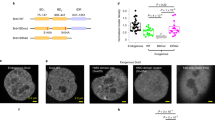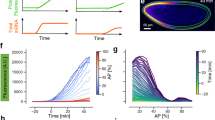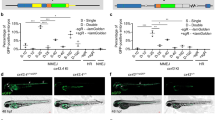Abstract
Zebrafish embryos offer a unique combination of high-throughput capabilities and the complexity of the vertebrate animal for a variety of phenotypic screening applications. However, there is a need for automation of imaging technologies to exploit the potential of the transparent embryo. Here we report a high-throughput pipeline for registering domain-specific reporter expression in zebrafish embryos with the aim of mapping the interactions between cis-regulatory modules and core promoters. Automated microscopy coupled with custom-built embryo detection and segmentation software allowed the spatial registration of reporter activity for 202 enhancer-promoter combinations, based on images of thousands of embryos. The diversity of promoter-enhancer interaction specificities underscores the importance of the core promoter sequence in cis-regulatory interactions and provides a promoter resource for transgenic reporter studies. The technology described here is also suitable for the spatial analysis of fluorescence readouts in genetic, pharmaceutical or toxicological screens.
This is a preview of subscription content, access via your institution
Access options
Subscribe to this journal
Receive 12 print issues and online access
$259.00 per year
only $21.58 per issue
Buy this article
- Purchase on Springer Link
- Instant access to full article PDF
Prices may be subject to local taxes which are calculated during checkout





Similar content being viewed by others


References
Pepperkok, R. & Ellenberg, J. High-throughput fluorescence microscopy for systems biology. Nat. Rev. Mol. Cell Biol. 7, 690–696 (2006).
Zon, L.I. & Peterson, R.T. In vivo drug discovery in the zebrafish. Nat. Rev. Drug Discov. 4, 35–44 (2005).
Lieschke, G.J. & Currie, P.D. Animal models of human disease: zebrafish swim into view. Nat. Rev. Genet. 8, 353–367 (2007).
Yang, L. et al. Zebrafish embryos as models for embryotoxic and teratological effects of chemicals. Reprod. Toxicol. 28, 245–253 (2009).
Westerfield, M., Wegner, J., Jegalian, B.G., DeRobertis, E.M. & Puschel, A.W. Specific activation of mammalian Hox promoters in mosaic transgenic zebrafish. Genes Dev. 6, 591–598 (1992).
Müller, F. et al. Intronic enhancers control expression of zebrafish sonic hedgehog in floor plate and notochord. Development 126, 2103–2116 (1999).
Barton, L.M. et al. Regulation of the stem cell leukemia (SCL) gene: a tale of two fishes. Proc. Natl. Acad. Sci. USA 98, 6747–6752 (2001).
Woolfe, A. et al. Highly conserved non-coding sequences are associated with vertebrate development. PLoS Biol. 3, e7 (2005).
Tran, T.C. et al. Automated, quantitative screening assay for antiangiogenic compounds using transgenic zebrafish. Cancer Res. 67, 11386–11392 (2007).
Liu, T. et al. Computerized image analysis for quantitative neuronal phenotyping in zebrafish. J. Neurosci. Methods 153, 190–202 (2006).
Vogt, A. et al. Automated image-based phenotypic analysis in zebrafish embryos. Dev. Dyn. 238, 656–663 (2009).
Kleinjan, D.A., Seawright, A., Childs, A.J. & van Heyningen, V. Conserved elements in Pax6 intron 7 involved in (auto)regulation and alternative transcription. Dev. Biol. 265, 462–477 (2004).
Lettice, L.A. et al. A long-range Shh enhancer regulates expression in the developing limb and fin and is associated with preaxial polydactyly. Hum. Mol. Genet. 12, 1725–1735 (2003).
Carninci, P. et al. Genome-wide analysis of mammalian promoter architecture and evolution. Nat. Genet. 38, 626–635 (2006).
Sandelin, A. et al. Mammalian RNA polymerase II core promoters: insights from genome-wide studies. Nat. Rev. Genet. 8, 424–436 (2007).
Juven-Gershon, T., Hsu, J.Y., Theisen, J.W. & Kadonaga, J.T. The RNA polymerase II core promoter—the gateway to transcription. Curr. Opin. Cell Biol. 20, 253–259 (2008).
Uemura, O. et al. Comparative functional genomics revealed conservation and diversification of three enhancers of the isl1 gene for motor and sensory neuron-specific expression. Dev. Biol. 278, 587–606 (2005).
Shkumatava, A., Fischer, S., Müller, F., Strahle, U. & Neumann, C.J. Sonic hedgehog, secreted by amacrine cells, acts as a short-range signal to direct differentiation and lamination in the zebrafish retina. Development 131, 3849–3858 (2004).
Strahle, U., Fischer, N. & Blader, P. Expression and regulation of a netrin homologue in the zebrafish embryo. Mech. Dev. 62, 147–160 (1997).
Müller, F. et al. Direct action of the nodal-related signal cyclops in induction of sonic hedgehog in the ventral midline of the CNS. Development 127, 3889–3897 (2000).
Hadzhiev, Y. et al. Hedgehog signaling patterns the outgrowth of unpaired skeletal appendages in zebrafish. BMC Dev. Biol. 7, 75 (2007).
Ellingsen, S. et al. Large-scale enhancer detection in the zebrafish genome. Development 132, 3799–3811 (2005).
Parinov, S., Kondrichin, I., Korzh, V. & Emelyanov, A. Tol2 transposon-mediated enhancer trap to identify developmentally regulated zebrafish genes in vivo. Dev. Dyn. 231, 449–459 (2004).
Scott, E.K. et al. Targeting neural circuitry in zebrafish using GAL4 enhancer trapping. Nat. Methods 4, 323–326 (2007).
Asakawa, K. et al. Genetic dissection of neural circuits by Tol2 transposon-mediated Gal4 gene and enhancer trapping in zebrafish. Proc. Natl. Acad. Sci. USA 105, 1255–1260 (2008).
Jin, S.W. et al. A transgene-assisted genetic screen identifies essential regulators of vascular development in vertebrate embryos. Dev. Biol. 307, 29–42 (2007).
Kuhn, R.M. et al. The UCSC genome browser database: update 2007. Nucleic Acids Res. 35, D668–D673 (2007).
Roure, A. et al. A multicassette Gateway vector set for high throughput and comparative analyses in ciona and vertebrate embryos. PLoS One 2, e916 (2007).
O'Boyle, S., Bree, R.T., McLoughlin, S., Grealy, M. & Byrnes, L. Identification of zygotic genes expressed at the midblastula transition in zebrafish. Biochem. Biophys. Res. Commun. 358, 462–468 (2007).
Ferg, M. et al. The TATA-binding protein regulates maternal mRNA degradation and differential zygotic transcription in zebrafish. EMBO J. 26, 3945–3956 (2007).
Wakaguri, H., Yamashita, R., Suzuki, Y., Sugano, S. & Nakai, K. DBTSS: database of transcription start sites, progress report 2008. Nucleic Acids Res. 36, D97–D101 (2008).
Müller, F. et al. Activator effect of coinjected enhancers on the muscle-specific expression of promoters in zebrafish embryos. Mol. Reprod. Dev. 47, 404–412 (1997).
Song, D.L., Chalepakis, G., Gruss, P. & Joyner, A.L. Two Pax-binding sites are required for early embryonic brain expression of an Engrailed-2 transgene. Development 122, 627–635 (1996).
Kikuta, H. et al. Genomic regulatory blocks encompass multiple neighboring genes and maintain conserved synteny in vertebrates. Genome Res. 17, 545–555 (2007).
Huang, C.J., Tu, C.T., Hsiao, C.D., Hsieh, F.J. & Tsai, H.J. Germ-line transmission of a myocardium-specific GFP transgene reveals critical regulatory elements in the cardiac myosin light chain 2 promoter of zebrafish. Dev. Dyn. 228, 30–40 (2003).
Zerucha, T. et al. A highly conserved enhancer in the Dlx5/Dlx6 intergenic region is the site of cross-regulatory interactions between Dlx genes in the embryonic forebrain. J. Neurosci. 20, 709–721 (2000).
Nakano, T., Windrem, M., Zappavigna, V. & Goldman, S.A. Identification of a conserved 125 base-pair Hb9 enhancer that specifies gene expression to spinal motor neurons. Dev. Biol. 283, 474–485 (2005).
Sanges, R. et al. Shuffling of cis-regulatory elements is a pervasive feature of the vertebrate lineage. Genome Biol. 7, R56 (2006).
Westerfield, M. The Zebrafish Book. (University of Oregon Press, Eugene, Oregon, USA, 1995).
Kimmel, C.B., Ballard, W.W., Kimmel, S.R., Ullmann, B. & Schilling, T.F. Stages of embryonic development of the zebrafish. Dev. Dyn. 203, 253–310 (1995).
Liebel, U. et al. A microscope-based screening platform for large-scale functional protein analysis in intact cells. FEBS Lett. 554, 394–398 (2003).
Acknowledgements
We thank N. Borel for fish care, K. Straatman, N. Groebner and P. Kobor for technical support, T. Becker (Brain and Mind Research Institute, University of Sydney) for the dre-mir9-1 enhancer and R. Sanges and E. Stupka for unpublished promoter analysis. This work was supported by FP6 projects EUTRACC and TRANSCODE, by the European Commission and the Deutsche Forschungsgemeinschaft to F.M. and programme grant by the Helmholtz Association of German Research Centres (HGF) to U.L. We thank the technical support team of Olympus Germany and Olympus UK, U. Strähle for general support and N. Foulkes and A. Cullinane for advice and critical reading of the manuscript.
Author information
Authors and Affiliations
Contributions
E.K. created the constructs, E.K., J.G. led the screening and imaging of embryos, M.R. designed and created automation software and automated image processing, F.M. and U.L. supervised the screen, M.F., Y.H., A.Z., C.S. and S.S. participated in the embryo screen. J.G., M.R., E.K. and F.M. analyzed data, U.L. designed and constructed the screening platform, F.M., E.K., J.G., M.R. and U.L. designed the study and J.G., M.R., E.K. and F.M. wrote the manuscript.
Corresponding authors
Supplementary information
Supplementary Text and Figures
Supplementary Figures 1–4, Supplementary Tables 1–3, 5–7, Supplementary Note (PDF 3433 kb)
Supplementary Table 4
Number of embryos and domain specific Venus signal intensity data of enhancer-promoter combinations assayed in this study (XLS 67 kb)
Supplementary Software
Zebrafish 2D reporter gene expression profiler (ZIP 132 kb)
Rights and permissions
About this article
Cite this article
Gehrig, J., Reischl, M., Kalmár, É. et al. Automated high-throughput mapping of promoter-enhancer interactions in zebrafish embryos. Nat Methods 6, 911–916 (2009). https://doi.org/10.1038/nmeth.1396
Received:
Accepted:
Published:
Issue Date:
DOI: https://doi.org/10.1038/nmeth.1396
This article is cited by
-
Synthetic promoter designs enabled by a comprehensive analysis of plant core promoters
Nature Plants (2021)
-
Acoustofluidic rotational tweezing enables high-speed contactless morphological phenotyping of zebrafish larvae
Nature Communications (2021)
-
Multi-template matching: a versatile tool for object-localization in microscopy images
BMC Bioinformatics (2020)
-
Asymmetric pitx2 expression in medaka epithalamus is regulated by nodal signaling through an intronic enhancer
Development Genes and Evolution (2018)
-
Generation of orientation tools for automated zebrafish screening assays using desktop 3D printing
BMC Biotechnology (2014)

